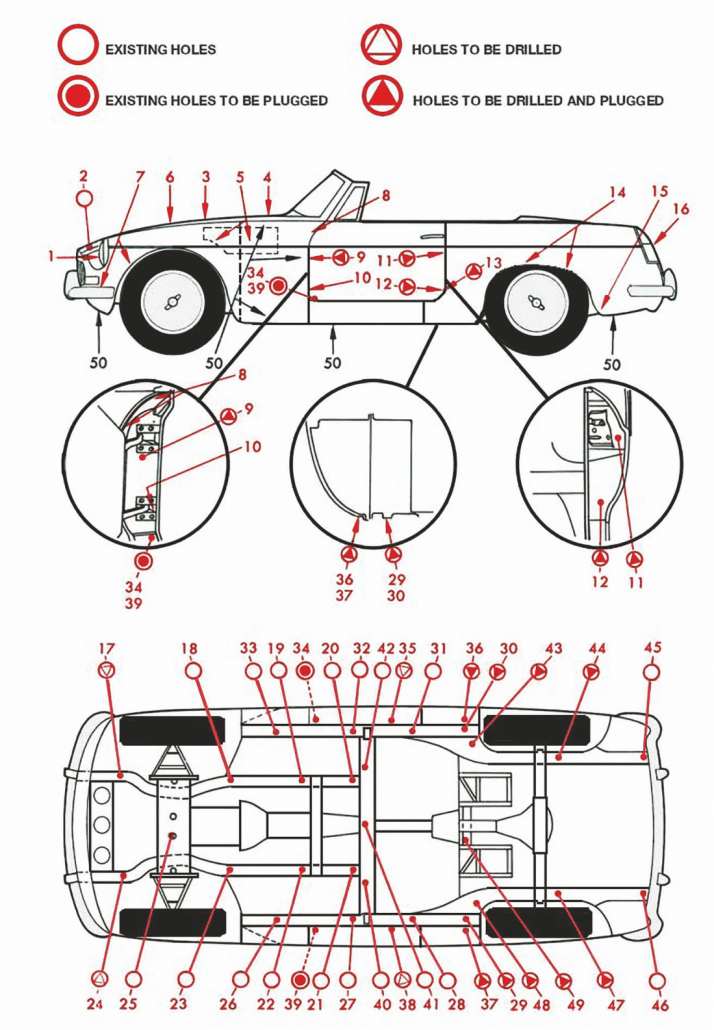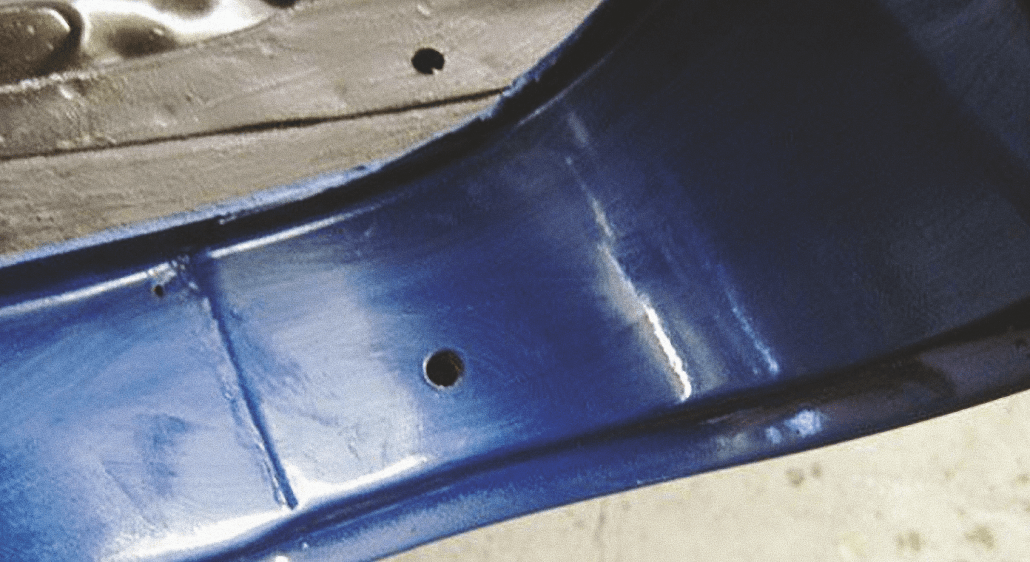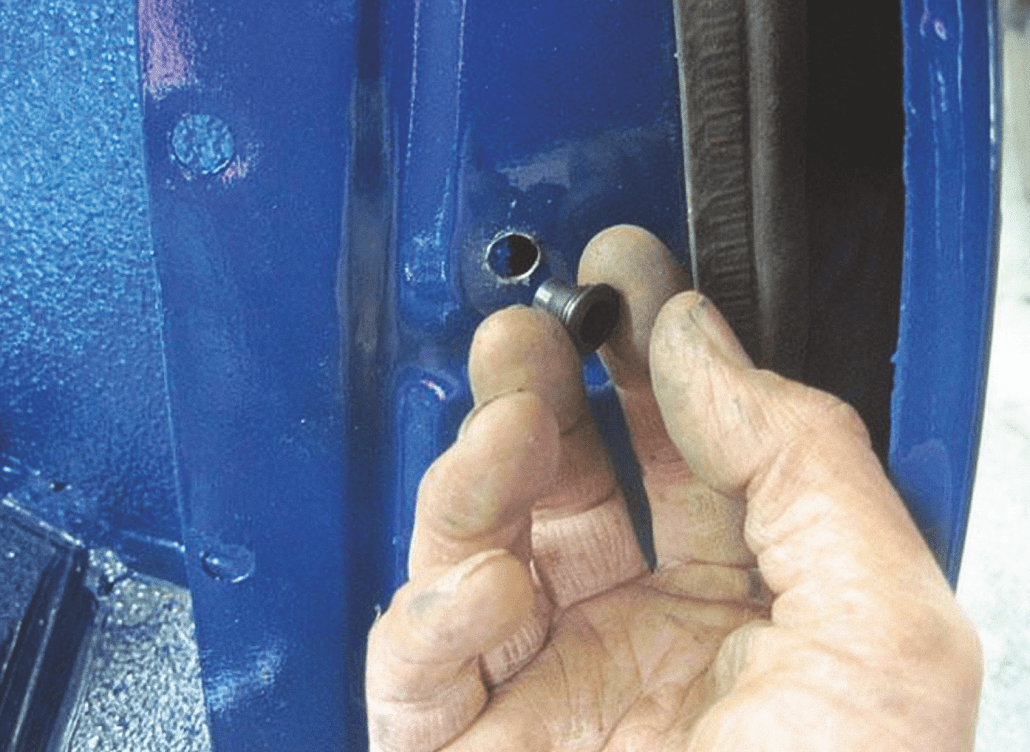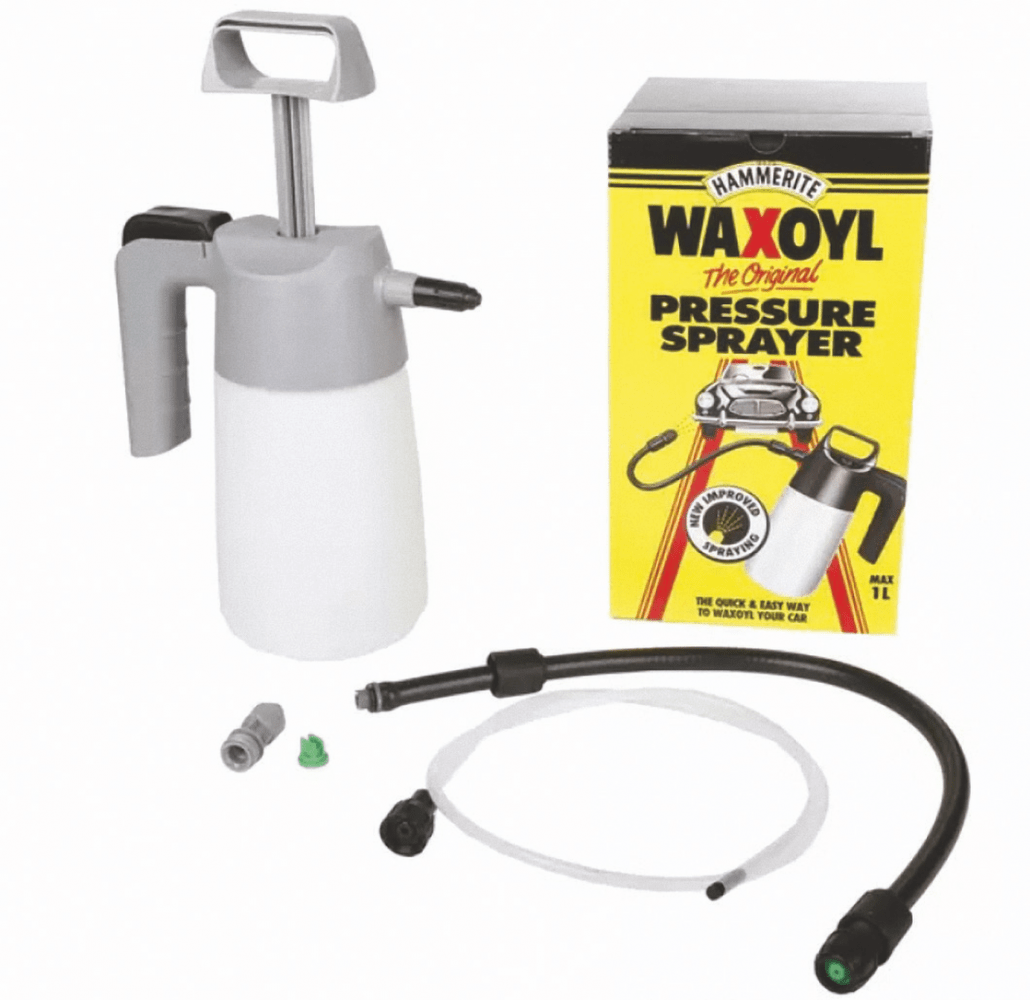You will need blanking plugs for these holes because they are exposed to view. There is also a hole at the front of the top of the outer sill close to the door seal. It is a very useful access to the front end of the outer sill.
The holes you need to drill are:
- Remove the shaped aluminium strip which secures the edge of the rubber carpet and the draught excluder to the projecting vertical seam between the two sills. Drill three 5/16 inch diameter holes through the rubber carpet and the inner sill (one in the middle and one at each end) in such a way that the aluminium strip will completely cover them when you replace it. I was interested to see this section had been overlooked when the car was professionally treated – fortunately it is still in good condition.
- Behind the seats the inner sill widens out to link up with the vertical panel across the front of the battery compartment. Carefully lift and turn back the rubber carpet to expose this area and now there is a double row of spot weld marks visible, you will need to drill one hole on each side of these welds because there appears to be a vertical web dividing the box section into two parts.
Injection and spraying
Now having done the preparation, let us get on with the messy bit – but really it is not that bad! Waxoyl is relatively clean, harmless stuff to use and if you are reasonably careful, you should not put it anywhere except where you want it. There are two basic operations – injection and spraying. I did the injection first.
Injection
Fit the long plastic tube with the “ nail” in the end to the Waxoyl gun. The “ nail” is a diffuser or spreader and should not be adjusted for best effect before starting. This is the one time when you are likely to get in a mess! At the front of the car, there are two main box section chassis members supporting the engine and gearbox unit. You should find two small plastic plugs or rubber bungs, one at each side of the base of the radiator, giving access to these box sections. Extract these bungs and put them in a safe place for refitting later. With the Waxoyl gun set up for injection, carefully push the long plastic tube through one of the holes in the direction of the rear of the car, working it back as far as it will go – almost its full length.
With the suction pipe well immersed in the Waxoyl can and gun and delivery pipe fully primed, give the trigger a fast powerful squeeze about once every second (giving it time to suck up another full charge from the can) and withdraw the probe about ½ inch after each squeeze of the trigger until the end of the tube appears at the hole again. But be warned: the probe can get stuck! You will need to be patient as you may have to feed the tube back in again a little and apply a twisting action until you can free it. Do not be tempted to pull hard on the tube or you will probably rip the “ nail” out of the end of the tubing and that will be the end of your nice spray pattern inside the section intended to coat all the internal surfaces. Having successfully done the rear part of the front chassis, turn the probe around and feed it forwards as far as the bumper, repeating the injection sequence as before. When complete, do the other side in the same way and then replace the bungs.
Moving back to the drillings around the door, insert the probe into each of the holes in turn and push it in every possible direction. It is worth mentioning here that during this stage of the work my trigger finger seized solid and had to be prized off the gun before it could be revived!
I should have had a glass of Heineken handy to revive the parts that… As you are working on this stage of the work, try and visualise the internal structure of the bodywork and aim to coat every inner surface of the bodywork with Waxoyl. Some Waxoyl will inevitably run out of the drain holes under the sills, so make sure they are clear first. You may feel it is worthwhile to use the drain holes as additional access points for the probe and another jet of Waxoyl. It is particularly important to ensure that all the seams between the various sheets of metal and panels are well dosed with Waxoyl as they are a favourite moisture trap.
Turning now to the forward door pillar, you will see a cavity ahead of the hinges at the top and a small gap between the pillar and the wing at the bottom. The cavity is easily dealt with – just push the probe in as far as it will go in every direction and squirt another blast of Waxoyl. Pay particular attention to that dogleg seam in that area just ahead of the windscreen on the top of the wing.
At the bottom of the door pillar you should have just enough room to poke the probe through the gap between the pillar and the wing. Push it forward as far as it will go until it comes up to the back of the splashguard behind the front road wheel. You can then either go berserk with Waxoyl injection from this position, turning and moving the probe around to cover every possible corner or, if you prefer, you can be more technical by removing the splashguard altogether and then blasting the Waxoyl in from the wheel arch. It is important to realise that water can get into that void past the splashguard and when it does it runs into the sills and out of the drain holes – provided they are clear! If you do not believe me, try it with a hosepipe.
Next the doors
The doors are next on the list for treatment. If you have removed the trims then you can use the spray nozzle. If not, then you will still need the probe to inject through the drilling in the rear face. Concentrate on the seams and the top edge of the outer skin. Remove the two plastic bungs on the top face of the door just above the hinges. A judicious squirt of Waxoyl through their two holes will help preserve the bolt heads and other bits and pieces visible inside. Replace the bungs. If you are satisfied that you have done the best job ever on the injection, put all the bungs back in their respective holes and replace the rubber carpet behind the seats and refit the aluminium door sill cappings. Wash the gun through with white spirit to clean the plastic probe tube, remove it and fit the short spray nozzle.
Spraying
Jack the car up enough to give you room to work underneath and chock it and insert axle stands for safety. No point being crushed underneath a beautifully Waxoyled MG that fell off its jack – you will not enjoy driving it then! Again, start from the front with the wheels removed and the brake discs well protected by bin liners, and spray all over the inside of the wheel arch, paying particular attention to the rear of the headlights – flood the stuff in there. Get it into the ledge on the inner wings, the seam along behind the chrome trim along the side of the car (another narrow ledge), round the edges (or lip) of the wheel arch and particularly around the splashguard by the door pillar. Continue spraying down onto the sill underneath and into every crevice right through to the back of the car. Pay particular attention to the extreme bottom edge of the sill. Treat the rear wheel arch and the areas in front of that odd little recess at the back of the sill – and behind it as well!
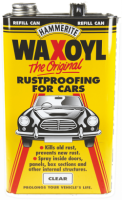 RUSTPROOFING
RUSTPROOFING
